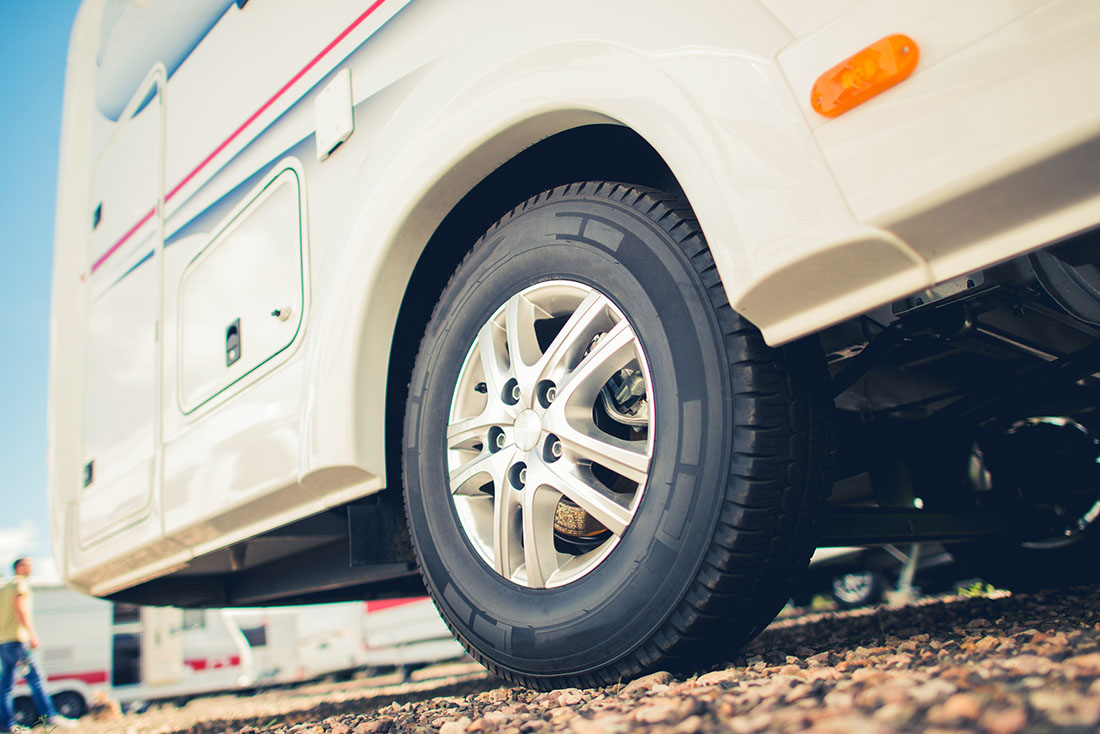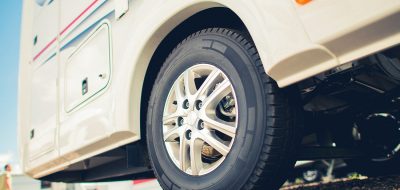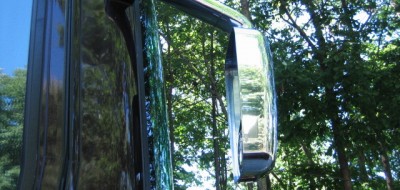RV Tire Pressure Monitoring Systems— a key safety feature.

TPMS
Onboard real-time TPMS (Tire Pressure Monitoring System) technology has been around for years. The early generation type was ITPMS (Indirect Tire Pressure Monitoring Systems). These systems electronically measured the tire rotations. This was designed on the principle that the inflation level of a tire changed the rolling distance per revelation. Therefore, a loss of pressure in a given tire would cause that wheel to rotate faster at the same speed. The second generation and most common today is the direct TPMS. These monitor the pressure and, if so equipped, the temperature of each tire.
Today, all automobiles sold in North America are equipped with a visual/audio tire pressure warning system. The National Highway Traffic Safety Administration claims that approximately 660 lives are saved each year by having the early warning from these devices. In addition, the agency reports that upwards of $533 million in fuel costs are saved by giving people the real-time information for corrective action.
RV Tire Pressure Monitoring — Peace of Mind
So, why are these not mandated on all new RV’s? Well, many things are not regulated at the same level as the mass vehicle market. The RV industry is a relatively small niche that may not be practical to govern in the same manner. Given time this will change.
I think clearly this is an option that one day will be a standard feature on all recreational motorized vehicles. However, in the meantime, specifying a TPMS be on your next motorhome is a smart move. Being proactive and adding an aftermarket TPMS on your existing unit is also a great move. Either way, it will probably pay for itself in fuel and tire-wear costs over the coming years.
There are very few products or accessories that you can add to your RV that will really save you money. The TPMS is one that can, while also providing an additional safety factor.
Peter Mercer – Watching the Air Between You and the Road







Peter Mercer
What a great story! The TPMS earns its keep right off. Good for you and such a good lesson. Thank you for your super success story on your added tire pressure monitor. Worth the BUCK$!!
Anonymous
My TPMS already paid for itself when an inner tire was losing pressure due to a bad o-ring during the tire install. My local truck tire repair shop told me that he gets quite a few coaches in where the outside tire blew out due to no air left in the inside dual tire. And lots of fiberglass around that area was destroyed in the process. I had thought the $500 system was probably a stupid purchase when I pulled the trigger. My thinking has changed significantly since.
Peter Mercer
The Tire Minder product generally performs well. However there can be challenges with any aftermarket screw-on sensors. Most of these type on sensors do not present any issues. I can not blame you for your no longer using them given your experiences. Perhaps an internal sensor system would better serve your needs and specific application. Thanks for sharing your experience. Best of luck should you pursue another product.
Peter Mercer
Yes, higher tire pressure results in less tire flex thus cooler running. However the temperatures such as 124 degrees F. and greater is not uncommon in many applications. Thanks for your input on this topic.
Peter Mercer
Great point! Tire pressure can be correct at the outset of a trip, but due to a road hazard change quickly while on route. Thanks for sharing your experience with us.
Peter Mercer
I can not speak for the make and model of the one you are using, but generally quality tire pressure monitors do warn of “Signal Lost”. Granted a slight delay may occur depending on the specific designed sample rate. I have had two such sensor failures and in both cases received timely warning. Keep in mind a tire can blow without warning or apparent cause, but this is by far less likely. In nearly 90% of the tire failures either rapid heat gain and or a low air pressure is present prior to the actual event.
Tire pressure monitors do not eliminate any tire issues, but they certainly help reduce such happenings and also serve to keep you informed as to needed tire maintenance.
Thanks for your comment.
Anonymous
I found that my Tow Dolly tires were getting up to 124 degrees with 44 lbs pressure, very hot at the rim. I raised them to 50 lbs and they did not exceed at 92 degrees since then.
Anonymous
I own the Tire Minder TM66. I think it helped me blow 2 tires, one of which took out the entire septic system. I replaced all 4 tires and the spare immediately and removed the TireMinders. The technicians at Discount Tire said they hear the complaint regularly. IF you don’t get the valve stem monitors screwed on exactly perfect, they cause the tire to leak. Once enough air has leaked out of the tire, it heats up and blows. I have rubber valve stems, but the technicians seemed to think that even solid metal stems didn’t make a difference. Fortunately I was on the way home so I could take my 5th Wheel directly into the maintenance shop but the blowout caused $2000+ damage The monitor works great since it tells you exactly when the tire blows. I won’t be using it again. I now check my tire pressure each time I stop.
Anonymous
I have TPMS on my 25 foot Winnebago View and they give me peace of mind. On a trip last year I noticed my right front was low on air and discovered a cut in the tire. Losing a tire at highway speeds is obviously very dangerous and running low on air is just the early warning. You can check them every morning before launch but can pick up a nail before you drive a short distance and never know it until too late. I have been using them for about three years and would not travel in my RV without them.
Anonymous
I think after market tire monitors are pretty much useless. All they do is monitor leaks and temperature. They do not tell you if you loose a tire (as I did). Nor are they guaranteed to alert you to a blowout. Even though they are suppose to have signal loss notification it can take days for it to recognize the trailer tire (s) are not on range of the base unit.
Anonymous
I think after market tire monitors are pretty much useless. All they do is monitor leaks and temperature. They do not tell you if you loose a tire (as I did). Nor are they guaranteed to alert you to a blowout. Even though they are suppose to have signal loss notification it can take days for it to recognize the trailer tire (s) are not on range of the base unit. The manufacturer told me it is not designed to notify you of blowouts or loss of tire. He really could not tell me why the loss of signal did not work. His only explanation was that feature was to monitor battery signal. Still doesn’t explain why no warning when battery is gone with the tire.
Peter Mercer
Have your trailer weighed and check each wheel position’s actual weight. Then check the tire/wheel rating capacity at the correct pressure. If the tire does not provide adequate capacity, or suitable margin, replace the tires with one rated higher. Remember that most people carry far more than they realize. Overweight is more often the cause of the owner not the RV maker. Thanks for sharing your experience.
Peter Mercer
Well, I believe the best systems are those that are installed within the tire. They can not only give you near real time air pressures, but also temperatures. I hate to mention brand names for fear of omitting one. There are many great choices to pick from. Thanks for the question. Hopefully some other members may post their favorites and why.
Anonymous
thanks for the advice- what do you think is the better choice of systems when purchasing for a 28 ft travel trailer? would like your input on this. Ive been doing a lot of reading and getting a lot of different opinions :*
Anonymous
I have owned a Montana fifth wheel for 7 years and have had 5 blow outs. I have used a TPMS for 2 years and it did not help me. Last month, while on vacation, I had two blowouts in 3 days. These involved 2 year old tires with tread separation. The readings from the TPMS showed no problem right up to the blowouts. I was told by the tire dealer that the Montana is overweight.